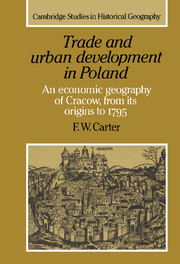Book contents
- Frontmatter
- Contents
- List of figures
- List of tables
- Preface
- Acknowledgements
- 1 Introduction: Cracow in context
- 2 Source materials and published literature
- 3 Cracow's early development
- 4 The political situation of Cracow, 1257–1500
- 5 European trade through Cracow, 1257–1500
- 6 The political situation of Cracow, 1500–1795
- 7 The commerce of Cracow, 1500–1795
- 8 Cracow: a final appraisal
- Appendix: Important dates in Cracow's history up to 1795
- Notes
- Select bibliography
- Index
- Cambridge Studies in Historical Geography
3 - Cracow's early development
Published online by Cambridge University Press: 07 October 2009
- Frontmatter
- Contents
- List of figures
- List of tables
- Preface
- Acknowledgements
- 1 Introduction: Cracow in context
- 2 Source materials and published literature
- 3 Cracow's early development
- 4 The political situation of Cracow, 1257–1500
- 5 European trade through Cracow, 1257–1500
- 6 The political situation of Cracow, 1500–1795
- 7 The commerce of Cracow, 1500–1795
- 8 Cracow: a final appraisal
- Appendix: Important dates in Cracow's history up to 1795
- Notes
- Select bibliography
- Index
- Cambridge Studies in Historical Geography
Summary
Fernand Braudel has stated that, ‘Every town grows in a given place, is wedded to it and does not leave it, except for rare exceptions. The site is favourable, to a greater or lesser degree; its original advantages and drawbacks stay with it for ever’. North of the Danube river many settlements were emerging between the seventh and tenth centuries as tribal centres, fortified religious sites and princely seats; they provided a haven of refuge, commonly sited in an advantageous defensive position. Evidence suggests that they were built surrounded by wooden stockades, strengthened by earth and masonry, within which lay permanently inhabited huts for craftsmen, workshops and often a stone-built church. By the late ninth century, the most important settlements dominated large areas of country and were often bishops' seats and princely castles. Gradually a separation took place between the princely/ecclesiastical functions of the settlement and the trading/artisans' quarters, a phenomenon already well defined by the eleventh century. By then, craftsmen, retainers, traders and artisans usually lived in a separate enclosure beyond the castle walls. These elementary Slav towns north of the Danube appear, until about the twelfth century, to have been largely based on local native effort with some external influences from the Church and small groups of German merchants and traders. As Rörig maintains, ‘The medieval town should not be thought of as a small, self-contained unit, but only within the framework of the organic inter-relationship of towns. Long-distance trade provided the basis on which urban life on the grand scale was founded and prospered. Each town was dependent on another for its functioning.’
- Type
- Chapter
- Information
- Trade and Urban Development in PolandAn Economic Geography of Cracow, from its Origins to 1795, pp. 42 - 62Publisher: Cambridge University PressPrint publication year: 1994



